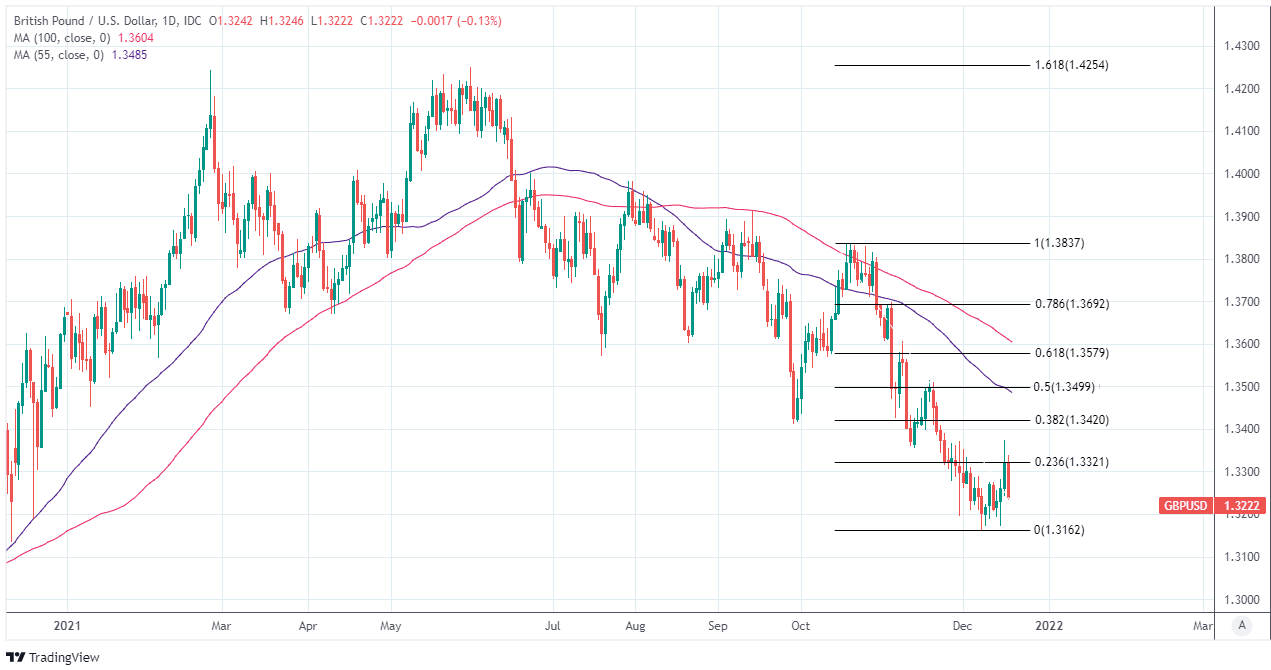Pound / Dollar Week Ahead Forecast: Retest of Support at 1.3167 Possible
- Written by: James Skinner
- GBP/USD’s BoE driven rally stalled by resistance on charts
- Rebound stymied at 1.3321, could prompt retest of 1.3167
- GBP/USD susceptible to USD strength & UK virus headlines
- U.S. PCE, UK GDP in focus in likely thin trading conditions

Image © Adobe Images
The Pound to Dollar exchange rate's attempted escape from the vicinity of recent December lows has been curtailed by a rebound in the U.S. Dollar, that if sustained could potentially see Sterling retesting its 2021 lows near 1.3167 ahead of year-end.
Pound Sterling enters the new week as one of the best performing major currencies of recent days with competition coming only from a U.S. Dollar that appeared to find its feet ahead of the weekend when losses sustained in the wake of Wednesday’s Federal Reserve (Fed) decision began to be reversed.
The Pound to Dollar exchange rate had been lifted briefly back above 1.33 when the Bank of England (BoE) surprised markets with its decision to lift Bank Rate from 0.1% to 0.25% last Thursday, although the rally was quickly curtailed over the course of Friday’s session.
This was as the Dollar appeared to draw a line under widespread losses that followed Wednesday’s Fed decision, which saw the market put on notice that the central bank could begin to lift U.S. interest rates as soon as the second quarter of next year and on as many as three occasions in 2022.
“Events this week do reinforce our view that when normal trading resumes in January that the US dollar is likely to remain well supported and appreciate further – especially against the low-yielding G10 currencies,” says Lee Hardman, a currency analyst at MUFG.
“The Fed are set to be much more active in tightening policy versus many other G10 central banks while the withdrawal of liquidity will also be conducive in supporting the dollar,” Hardman and colleagues said in a note on Friday.
Above: Pound-Dollar rate shown at daily intervals with Fibonacci retracements of October’s fall indicating likely areas of technical resistance.
- GBP/USD reference rates at publication:
Spot: 1.3216 - High street bank rates (indicative band): 1.2853-1.2946
- Payment specialist rates (indicative band): 1.3097-1.3150
- Find out about specialist rates, here
- Set up an exchange rate alert, here
- Book your ideal rate, here
December’s dot-plot of Fed policymakers’ forecasts suggested the Fed could lift its interest rate further and faster than the BoE next year, an outcome that has not yet been fully priced-in by interest rate markets and which could be set to act as a headwind for the Pound-Dollar rate in the weeks ahead.
This is after inflation rose further above six percent in the U.S. in November, prompting the Fed to accelerate the winding down of its quantitative easing programme last week so that it ends next March rather than in June, and to also warn that interest rates could rise sooner than previously thought.
“The Fed's pivot is far from complete, in our view. We see US inflation well above market expectations next year and, as a result, the Fed way behind the curve, having to hike more than the consensus expects, starting in March and at least every quarter thereafter until early 2024,” says Athanasios Vamvakidis, head of FX strategy at BofA Global Research.
“We do not think the GBP rebound is a game changer. We continue to favor a weaker pound into 2022, as we think the cyclical and structural backdrop will deteriorate, making the Bank of England's job harder to satisfy market rate hike expectations. Our bias is therefore to fade this GBP rally but we are cognizant of the build-up of bearish sentiment/positioning,” Vamvakidis and colleagues said in a Friday note.
Market pricing still implied last Friday that the Fed is unlikely to lift its interest rate before June next year, meaning the greenback and Pound-Dollar rate could be sensitive to the outcome of this Thursday’s U.S. PCE figures.
{wbamp-hide start}
{wbamp-hide end}{wbamp-show start}{wbamp-show end}
The Personal Consumption Expenditures Price Index is the preferred inflation measure of the Fed and so the Dollar could be sensitive to whether it extends further above 5% this week as that could lead the market to bring forward the time at which it expects the Fed Funds rate to begin rising.
“The Fed’s shift has been partly priced in, but we think markets may still under-appreciate the timing and pace of funds rate hikes (our economists now expect a first rate increase in March),” says Zach Pandl, co-head of global foreign exchange strategy at Goldman Sachs, writing in a Friday note.
“Our forecasts still envision that the Dollar will be flat-to-down over the course of 2022 due to healthy global growth and rate hikes by other central banks (e.g. the Bank of Canada) that keep pace with the Fed. But over the near-term we would expect Dollar strength to continue,” Pandl also said.
A strong PCE number would be a risk to the Pound-Dollar rate, which may also be sensitive to coronavirus developments in the UK where weekend headlines suggest the government is facing a clamour from its advisers for more stringent restrictions to be introduced now the Omicron variant is digging its heels in.
Further declines for Sterling, whether due to a strengthening Dollar or pandemic risks in the UK, could ultimately see it retesting 2021 lows and a major level of technical support around 1.3167 over the coming days.
“We may enter a phase of trading over the coming weeks in less liquid market conditions when FX moves might prove detached from fundamental drivers,” warns MUFG’s Hardman.
Above: GBP/USD shown at weekly intervals with Fibonacci retracements of 2020 recovery indicating likely areas of technical support.







